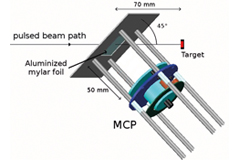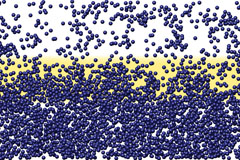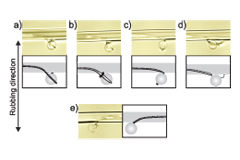Accurate dating requires calibration down to the last ion (Vol. 46 No. 3)

A new solution accurately counting the exact amounts of ions from laboratory radiation exposure helps to simulate the natural radiation of quartz samples used for thermoluminescence dating.
Thermoluminescence is used extensively in archaeology and the earth sciences to date artefacts and rocks. When exposed to radiation quartz, a material found in nature, emits light proportional to the energy it absorbs. Replicating the very low dose of background radiation from natural sources present in quartz is a key precondition for precise and accurate dating results. The authors have now developed a method to control the accuracy of the dose calibrations delivered to the samples during laboratory irradiation with heavy particles, replicating natural radiation exposure. Using oxygen and lithium ions from the Tandem accelerator at INFN LABEC in Florence, they found that their measurements were accurate to within 1%, despite large fluctuations in the irradiation beam.
L. Palla, C. Czelusniak, F. Taccetti, L. Carraresi, L. Castelli, M.E. Fedi, L. Giuntini, P. R. Maurenzig, L. Sottili, and N.Taccetti,, Accurate on line measurements of low fluences of charged particles, Eur. Phys. J. Plus 130, 39 (2015)
[Abstract]
Advanced simulations shed light on fluid interfaces (Vol. 46 No. 3)

Any piece of liquid matter requires confinement by solid or fluid boundaries. The simplest case is the interface between liquid and its corresponding vapour. This is subject of ongoing research, pioneered by the Dutch physicist van der Waals 120 years ago. One long-standing problem is about the surface tension at the nanometre scale, for which theory and experiments suggest a high length-scale sensitivity. However, various previous computer simulations found little evidence for this and reached contradictory conclusions.
In this work the authors re-open the case and present a fresh view on fluid interfaces by combining high-performance simulations with proposing a new way of analysing X-ray scattering (GISAXS) experiments. They discover an unexpected dependence of the surface tension on temperature and wavelength, with possibly far-reaching implications for nanoparticle probes, wetting films, and droplet nucleation. The new insight was achieved by utilising novel accelerator hardware, which provides an energy-efficient platform for massively parallel computing and boosts the new supercomputer “Hydra” of the Max Planck Society.
F. Höfling and S. Dietrich, Enhanced wavelength-dependent surface tension of liquid-vapour interfaces, EPL, 109, 46002 (2015)
[Abstract]
Rodeo in liquid crystal (Vol. 46 No. 3)

Scientists have achieved an unprecedented level of control over defects in liquid crystals that can be engineered for applications in liquid matter photonics.
Sitting with a joystick in the comfort of their chairs, scientists can play “rodeo” on a screen magnifying what is happening under their microscope. They use very strong laser tweezers to locally melt the liquid crystal into a phase where the molecules are oriented in all directions, encircling one part of the fibre. They subsequently switch-off the laser light, resulting in molecules reverting back from being oriented in all directions to being parallel to each other, creating several pairs of defects—akin to localised disruptions of the crystal’s ordering field —forming a ring. The defect ring is used as a non-material "rope" to entangle and strongly bind a microsphere and long fibre of micrometric diameter. The results of this work have been published recently by the authors. They believe that their findings could ultimately open the door to controlling the flow of light using light of a specific frequency in the Gigahertz range in liquid crystal photonic microdevices.
M. Nikkhou, M. Škarabot and I. Muševič,, Topological binding and elastic interactions of microspheres and fibres in a nematic liquid crystal, Eur. Phys. J. E, 38, 23 (2015)
[Abstract]
Supersymmetry unveiled in periodic optical media (Vol. 46 No. 3)

Supersymmetry (SUSY) was conjectured in quantum field theory as a means to unify bosons and fermions. While SUSY would be helpful in solving paradoxes such as the cosmological constant problem, its evidence in particle physics remains elusive. However, SUSY can be applied to other areas of physics, ranging from quantum mechanics to optics.
Supersymmetric optics is a recent and promising research field. It enables to synthesize dielectric media with target scattering properties and with less stringent material requirements than e.g. metamaterials synthesized by transformation optics. SUSY optical structures can realize efficient mode conversion, spatial multiplexing, transparent interfaces and optical intersections.
In this work, the author has now disclosed the SUSY property of periodic optical media. SUSY in grating structures can find important applications to the synthesis of Bragg filters and distributed-feedback optical cavities. For example, the author describes how multiple SUSY can be used to design frequency comb transmission filters (see Figure).
Optical SUSY in periodic media is a powerful design tool that can be extended to include gain and loss, i.e. distributed feedback lasers, as well as optical media with parity-time (PT) symmetry.
S. Longhi,, Supersymmetric Bragg gratings, J. Opt. 17, 045803 (2015)
[Abstract]
Pionic-Hydrogen Atom and Quantum Chromodynamics (Vol. 46 No. 3)

Analogous to the vast amount of knowledge acquired on the electronic hydrogen atom over the last century as a probe of Quantum Electrodynamics, hadronic physics is using “pionic hydrogen” - a hydrogen atom where the electron is replaced by a negatively charged pion - as a laboratory for investigating Quantum Chromodynamics (QCD). The small Bohr radius of pionic hydrogen offers a large sensitivity to the strong pion-proton interaction, leading to an energy shift compared to the ground state energy if only the electromagnetic interaction is considered. The precise determination of this shift provides a benchmark of our understanding of the strong interaction from basic principles in QCD. To this end an exquisite experiment was devised and performed at the high intensity, low energy pion beam at the Paul Scherrer Institut using the cyclotron trap and an ultimate resolution Bragg spectrometer leading to an impressive four fold improvement compared to the previous best measurement as shown in the figure.
M. Hennebach et al. (+14 co-authors), Hadronic shift in pionic hydrogen, Eur. Phys. J. A 50, 190 (2014)
[Abstract]
Disparity in electron and phonon mean-free-paths (Vol. 46 No. 3)

There has been intensified interest in high performance thermoelectric materials in the last two decades, largely owing to the nanostructuring approaches that significantly reduce heat leakage by phonons. A condition for the nanostructuring approaches to be effective is the phonon mean free path (MFP) much longer than that of electrons so that phonons are more frequently scattered at the interfaces. While there has been a recent significant progress in the first-principles understanding of phonon MFP spectral distributions, the spectral distribution of electron MFPs remains unknown.
In this work the authors compute from first-principles the energy dependent electron scattering and MFPs in silicon. They show that electrons and phonons have very different MFP distributions with phonon MFPs significantly longer than those of electrons. The authors show with a model that silicon 20 nm grains can yield a more than five times enhancement in the thermoelectric figure of merit, since the grain boundaries scatter phonons more significantly than electrons due to their different MFP distributions. This work provides new fundamental insights by quantitatively revealing the disparity in electron and phonon MFP distributions from first principles.
B. Qiu, Z. Tian, A. Vallabhaneni, B. Liao, J. M. Mendoza, O. D. Restrepo, X. Ruan and G. Chen, First-principles simulation of electron mean-free-path spectra and thermoelectric properties in silicon, EPL, 109, 57006 (2015)
[Abstract]
Novel high-power microwave generator (Vol. 46 No. 3)

A new study explores the viability of a novel structure to be used as a component of a high-power microwave source, designed to transfer energy to targets via ultra-high-frequency radio waves.
High-power microwaves are frequently used in civil and military applications. In a new study the authors demonstrate that their proposed novel method, which is capable of producing such microwaves, offers a viable alternative to traditional approaches.
To generate such high-power microwaves, researchers rely on devices referred to as backward wave oscillators, which are designed to transform the energy of an intense electron beam propagating in a slow electro-dynamic structure—SWS—into electromagnetic radiation at microwave frequencies.
Metallic cylinders with a sinusoidally shaped, periodically corrugated inner wall are being extensively used as SWS. But they are difficult to manufacture. Now, the authors propose an alternative shape of the SWS, in the form of a novel semi-circular structure and prove it is a viable alternative for generating high-power microwaves.
Md. Ghulam Saber, R.Hasan Sagor and Md. Ruhul Amin, Numerical study of the dispersion characteristics of a semi-circularly corrugated slow wave structure, Eur. Phys. J. D 69, 38 (2015)
[Abstract]
The new frontier in plasma medicine (Vol. 46 No. 3)

Data on the transport of electrical charges in water vapour provide the key ingredients to new plasma models applicable to medicine.
Applications of plasmas in medicine are a new frontier in therapeutic treatment. For example, they can help in stimulating tissue regeneration in the contexts of wound healing and dermatology. Before these and further applications can be developed, it is essential to understand the processes at work in plasmas—a unique kind of gas-like state of matter containing charged particles. Now a study published by the authors provides previously unavailable data on oxygen ion transport and the likelihood of such ions interacting with water molecules. These could contribute to new models of plasmas in liquids which account for how discharges are created in water vapour.
V. Stojanović, Z. Raspopović, D. Marić and Z. Lj. Petrović, Cross sections and transport of O- in H2O vapour at low pressures, Eur. Phys. J. D 69, 63 (2015)
[Abstract]
Subtracted dispersion relation estimate of two-photon exchange (Vol. 46 No. 3)

Elastic electron-proton scatterings (with one-photon exchange) have always provided fundamental information on general properties of the proton. Recently, two experimental approaches, with and without polarized protons, gave strikingly different results for the electric over magnetic proton form factor ratio. Similarly, a mysterious discrepancy (“the proton radius puzzle”) has been observed in the measurement of the proton charge radius in different experiments, one of which is electron-proton scattering. Two-photon exchange (TPE) contributions have been proposed as a plausible solution to resolve the puzzles, but their estimates have strong model dependences. A quantitative understanding of TPE effects, based on general principles and avoiding model dependences, is necessary. A subtracted dispersion relation formalism for the TPE has been developed and tested. Its relative effect δ2γ on the elastic cross section is in the 1-2 % range for a low value of the momentum transfer Q2 as function of the kinematic parameter ε, ranging between ε = 0 (backward scattering) and ε = 1 (forward scattering). Summarizing, the paper studies in a theoretical framework which minimizes the model dependence, the TPE contributions to electron-proton scattering, a precision experiment crucial for measuring the most fundamental proton properties.
O. Tomalak and M. Vanderhaeghen, Subtracted dispersion relation formalism for the two-photon exchange correction to elastic electron-proton scattering: Comparison with data”, Eur. Phys. J. A 51, 24 (2015)
[Abstract]







